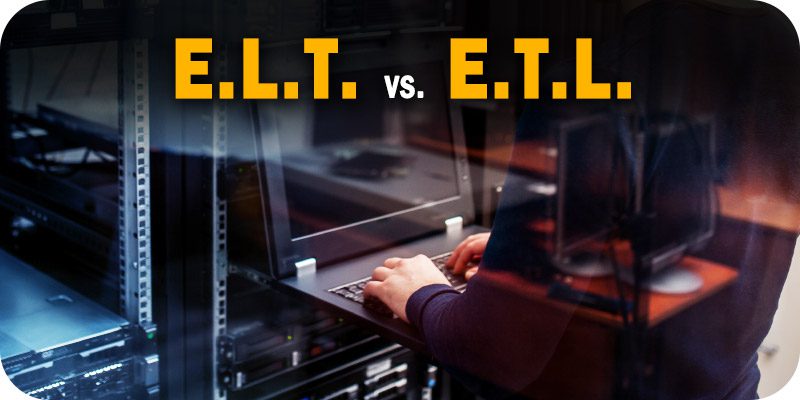ELT vs. ETL Data Integration; What’s the Difference?


This is part of Solutions Review’s Premium Content Series, a collection of contributed columns written by industry experts in maturing software categories. In this submission, Matillion Manager of Developer Relations Ian Funnell offers a contrast on different data integration technologies; ELT vs. ETL.
 Cloud data warehouses are one of the most popular PaaS solutions around – 54 percent of organizations utilize these services with another 15 percent planning to in the near future. Since the start of widespread adoption around 2013, cloud data warehouses have provided nearly infinitely scalable compute power. With vast and ever-increasing amounts of data comes a need to make sense of it all – through an integration process known as Extract, Transform, Load (ETL).
Cloud data warehouses are one of the most popular PaaS solutions around – 54 percent of organizations utilize these services with another 15 percent planning to in the near future. Since the start of widespread adoption around 2013, cloud data warehouses have provided nearly infinitely scalable compute power. With vast and ever-increasing amounts of data comes a need to make sense of it all – through an integration process known as Extract, Transform, Load (ETL).
While ETL has been around for many years and is commonly associated with on-premise technology, the accelerated move to the cloud has made another approach more common – Extract, Load, Transform (ELT). Despite the rise in popularity of ELT in the cloud-driven world, many people throughout the tech industry still use the common acronym, ETL, when referencing ELT, despite fundamental differences between the two. While the letters in each acronym stand for the same words, order matters, and mixing the two up could prove to be very costly for the organization. Both ETL and ELT offer unique benefits – and organizations need to understand how to distinguish between the two when deciding which to apply to individual use cases.
ELT vs. ETL; What’s the Difference?
ETL is the traditional method and involves extracting data from different sources, transforming the data on an ETL server, and then loading the transformed and integrated data into a data warehouse, where it is ready for analytics and visualization. Usually performed in an on-premise server, ETL is a very compute-intensive process that requires a lot of data transfer, parsing, transformation, and lookups.
The newer, cloud-based approach – ELT – involves the same activities, but rather than transforming the data in a separate ETL engine, the power of the cloud warehouse itself is used to transform the raw data that was loaded in. ELT is also very compute-intensive, but the work occurs inside the cloud data warehouse, an environment that has been optimized for these workloads.
While both serve similar purposes, the location where the transformation happens is a key differentiator between the two approaches. While there is no singular answer to which is “better,” there are different scenarios in which one would make more sense – and be more cost-effective – than the other.
The Costs of ETL and ELT
Performing sophisticated transformation and integration tasks on a high quantity of data is an intensive process that can be expensive. ETL requires two high-powered architectural components: an ETL server and a cloud data warehouse. Because the environments that run ETL software are not built to scale in the same way that cloud data warehouses are today, when data volumes increase and workloads become more complex, these traditional environments tend to hit limits. This can create bottlenecks in the data supply chain and can negatively impact reporting and analytics. Subsequently, organizations might miss opportunities by making business decisions with outdated, incomplete, or inaccurate data.
On the ELT front, transformations are done in the cloud database, which means that only one high-powered architectural component is required – the cloud data warehouse itself. ELT requires the same amount of compute power as ETL, but the data is copied less from place to place. Getting the proper amount of space and power can be expensive, and without it, performance and queries will suffer. Cloud data platforms are more cost-effective than on-premise architectures, but this is still a considerable cost decision-makers need to keep in mind. ETL can also be more time-consuming due to additional writes required at each step of the process, costing data teams valuable time.
ELT vs. ETL: How to Determine Which Process to Use
Understanding the differences between ETL and ELT is vital to ensuring that an organization is using the right approach to meet their needs. Ideally, the choice between ETL and ELT should be determined on a project-by-project basis. Below are a few scenarios in which one would be a better option over the other:
ETL:
- If the data in question is predictable, only comes from a few sources and transformations are minimal, ETL may be the more effective strategy.
- ETL is more attuned to work with traditional databases over modern MPP platforms.
- Due to the specialized nature of ETL compute platforms, ETL is more easily able to handle unstructured source data.
ELT:
- If the data’s specific use case is not quite known yet, ELT allows for the freedom to transform at a later stage once its use case becomes clearer.
- ELT is more attuned to work with modern MPP platforms.
- ELT offers the ability to present the same data simultaneously in multiple different ways, for example as Data Vault, 3rd Normal Form, and Star Schema. This can be helpful in enabling data sharing and self-service.
It is clear that ETL and ELT can both be beneficial to an organization. Organizations need to be keen on the differences between the two and understand the best use cases for both, especially amidst a climate of ever-tightening IT budgets and a push for more efficient and effective work processes. As we look to the future of data, analytics, and the cloud, these differences, and their associated costs are vital to keep in mind to ensure business success.




















